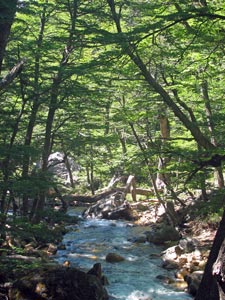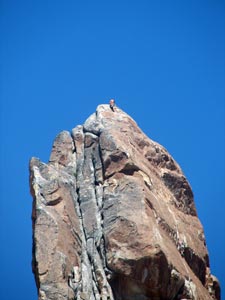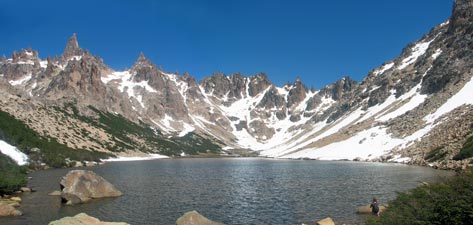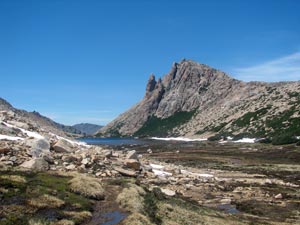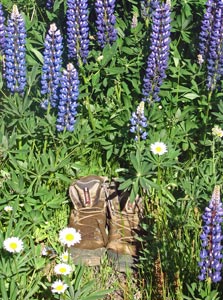Just over nine months ago we had started our South American adventure with a four-day trek across the Nahuel Huapi National Park. It was a magnificent introduction to the landscapes of the Andes Mountains and it seemed appropriate that our last foray should be in the same region. With only one day left, we needed one last hard walk before our 19 hour plane journey home; the circuit of the Cerro Catedral ridge was just the one, so we drove up to the ski village of Villa Catedral, a few kilometres outside of Bariloche, and set off from the carpark on another glorious sunny Patagonian summer's day.
|
|
|
|
|
|
|
The head of the track was a dirt road on the southern end of the carpark, but we quickly turned off that onto a wide and dusty walking path that led into the ñirre and quila bamboo scrub. We climbed gently through bush along a route lined with scrambling pink flowering pea-creepers, patches of blue lupins, cream and white daisies and the odd green orchid. The track led us across a platform high above the waters of Lago Gutierrez, crossing several steep little gullies carrying water down from the heights above.
|

Quila bamboo regrowth in the burnt beech forest
|

Traversing the slopes above Lago Gutierrez |

First glimpse of the towers of Cerro Catedral
|
Ahead we could see the sad sight of the dead burnt trunks of ñirre and lenga - a fire had obviously passed through some years earlier. The quila bamboo had recovered with a vengeance, the beech trees less so, but with the removal of the canopy, a host of wildflowers flourished in the open habitat - yellow topa-topas, the paradoxical yellow violets, plus daisies and pea-flowers of various hues. The track now crossed a much steeper slope as the ridge ran more directly up from Lago Gutierrez, and we found ourselves below an impressive grey rock face that guided us into the mouth of Arroyo van Titter, a deep cleft that would lead us up into the mountains. The cleft of the arroyo framed our first glimpse of the rocky spires of Cerro Catedral.
|
Setting off again, we followed the path, a faint trace marked by occasional red and yellow paint spots, northward across the steep boulder scree on the western side of the Cordon Catedral; 800m below us, the Arroyo Rucaco tumbling down its green-clad valley in a series of cascades and waterfalls, a hundred metres above us the jagged rampart of grey, tan and black rocks of this razorback ridge. The sun shone hotly, as at times we wandered across a loose sandy scree, its slopes speckled with the occasional pastel coloured gems of the prostrate wildflowers that eked out their lives in this arid environment, and at other times we picked our way carefully up and down the sharp rocky outcrops that jutted out from the ridgeline.
|

Waterfall on Arroyo Rucaco 800m below us
|

The jagged profile of Punta Princesa
|

View through a gap to the Arroyo van Titter |

Boot-skiing - the fast way down

|
The upper slopes still held large drifts of slushy spring snow. We looked at the snow, looked at each other, nodded and took off on the most direct route down - boot-skiing down a succession of long drifts until we rapidly arrived at the snow-free middle slopes with saturated feet and exhilarated minds.
|
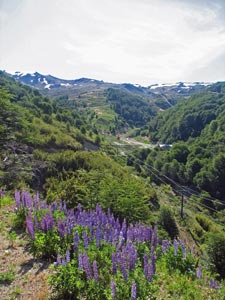
Mid slopes of the ski field

|

Daisy covered fields of the lower ski slopes
|

The ubiquitous Patagonian lapwing
|
The only downside to this was that we had slid into the zone of the tabaño, the feared biting fly of the Patagonian Andes (like a March fly on steroids). They had only just emerged from over-wintering and the females were ravenous for blood. Dark hordes plagued us as we followed the network of access roads down through the lupins and daisy fields of the lower slopes to return once again to the villlage and the fly-free shelter of the car. Perhaps we had chosen the right time to move on.
|











